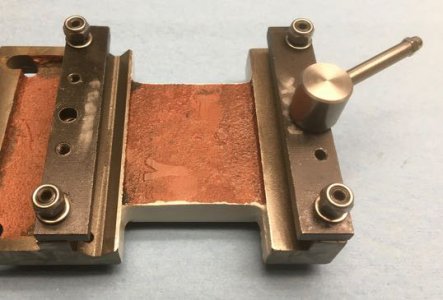Since posting the above, I've been looking into alternatives to the LMS Carriage Lock as I have never liked the location of the locking handle. All of the ideas I could find for the tailstock side of the saddle blocked access to the cross-slide gib screws or my cross-slide lock:
However, I realized I had a third option for the location of a carriage lock: if you look closely at the photo above, you will see that I modified the saddle retainer setup. Combining ideas from Frank Hoose, Steve Jordan, LMS and David Fenner, I replaced the stock cap screws & set screws with M6-1.0 x 30mm set screws & Nylock nuts at the four corners:
This leaves the center hole in the back retainer empty, an the M6-1.0 hole in the saddle looking for something to do. The gap between the back retainer and bottom of the saddle is only about 0.005", so I tried using a cap screw to lock the carriage - it worked perfectly. I then made a locking bolt (tried one of my little blue adjustable lever wing nuts, but it was awkward):



The body is made from 3/4” 12L14 round bar, the handle is 1/4” drill rod and the rest are hardware. The M6-1.0 x 25 setscrew and M4-0.7 cap nut are secured with red threadlocker, and the “working end” of the setscrew is coated with Vibra-Tite to prevent the lock from accidentally engaging. The cap nut finishes the handle nicely, and also provides a means of unscrewing the handle without having to mill flats on the shaft. The location of the cross hole for the handle was determined after everything else was assembled so it goes from unlock to lock with good access and room for wear without having to make a custom washer:
Since the lock is out of sight, I added a reminder label on the backslash:
I've attached a drawing; anyone may use the concept for their personal use, but I would appreciate acknowledgement.


